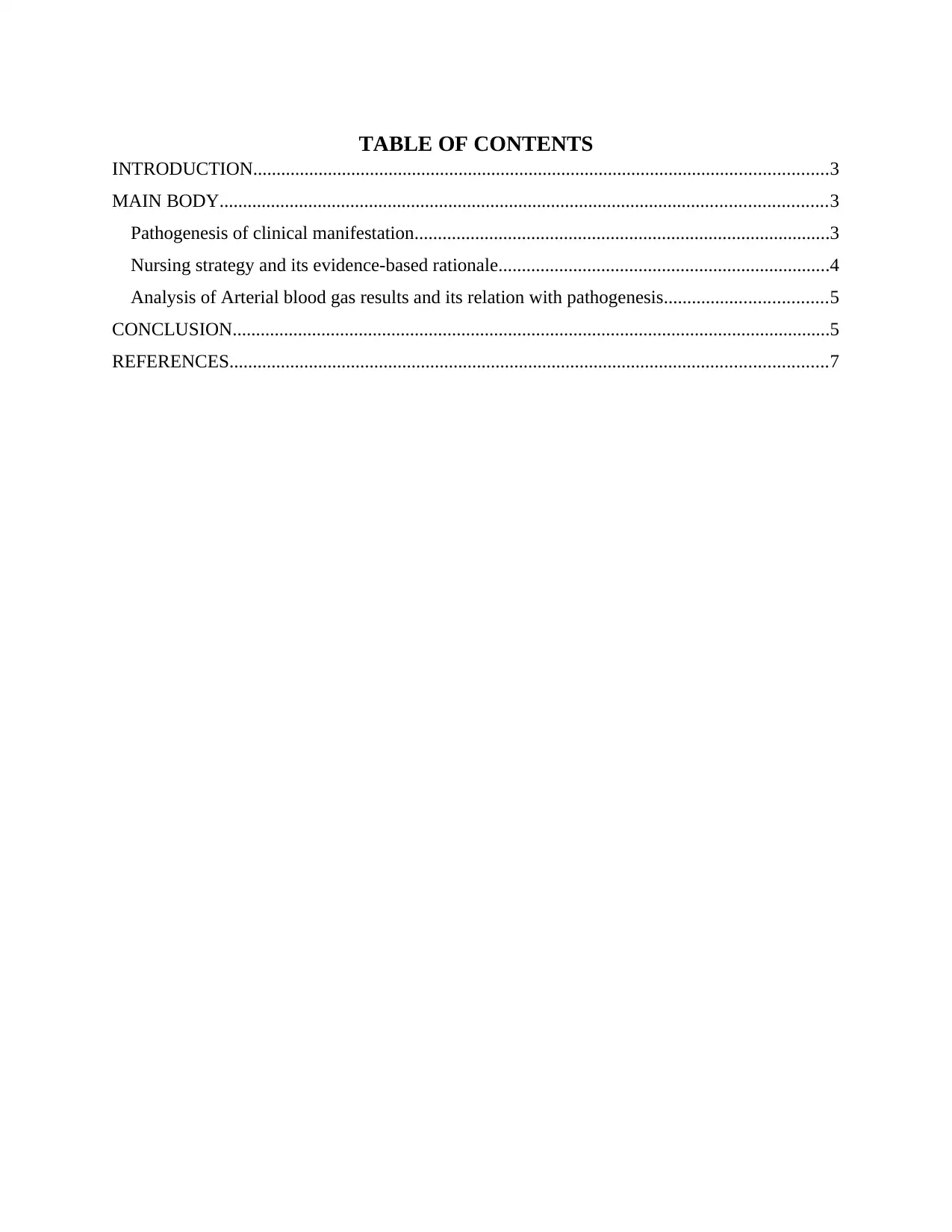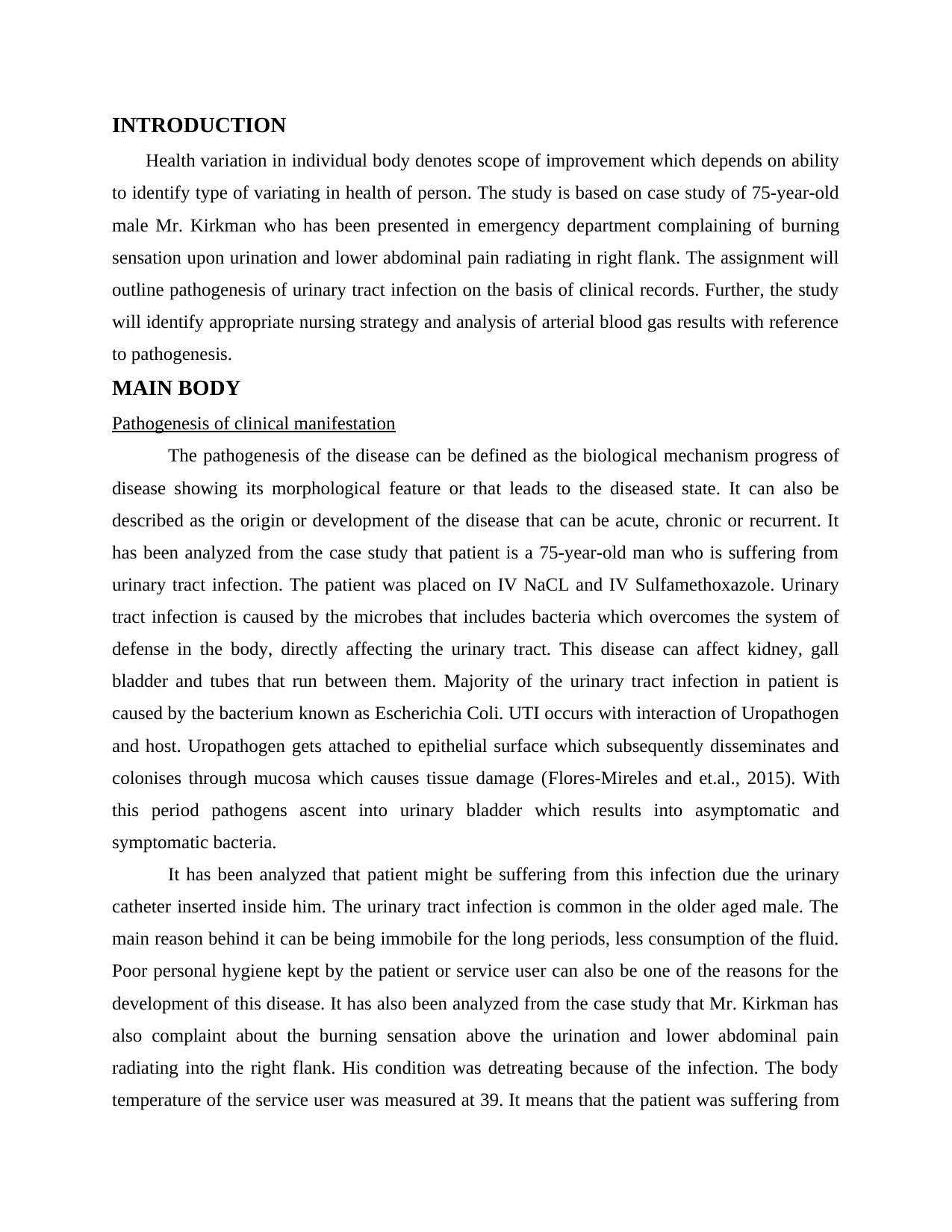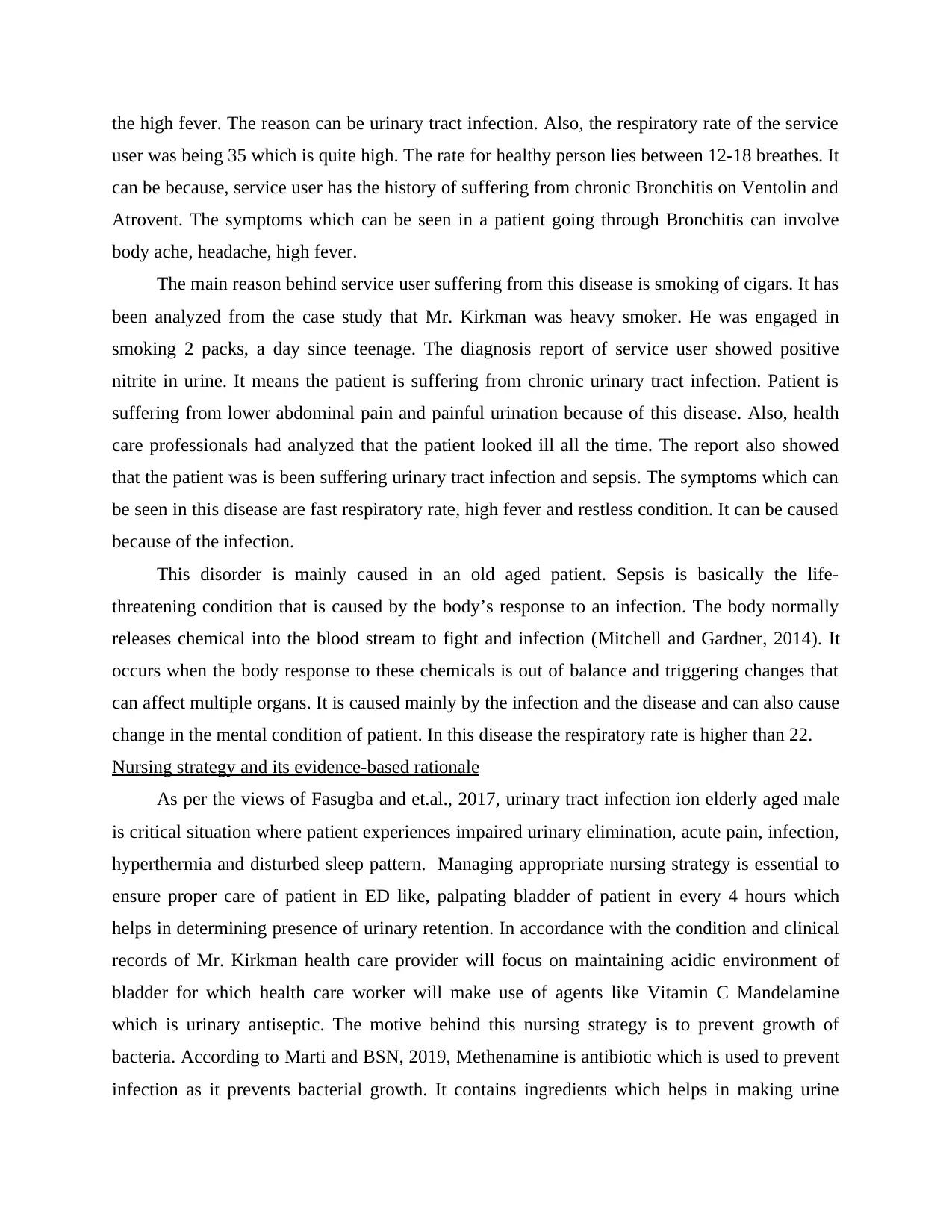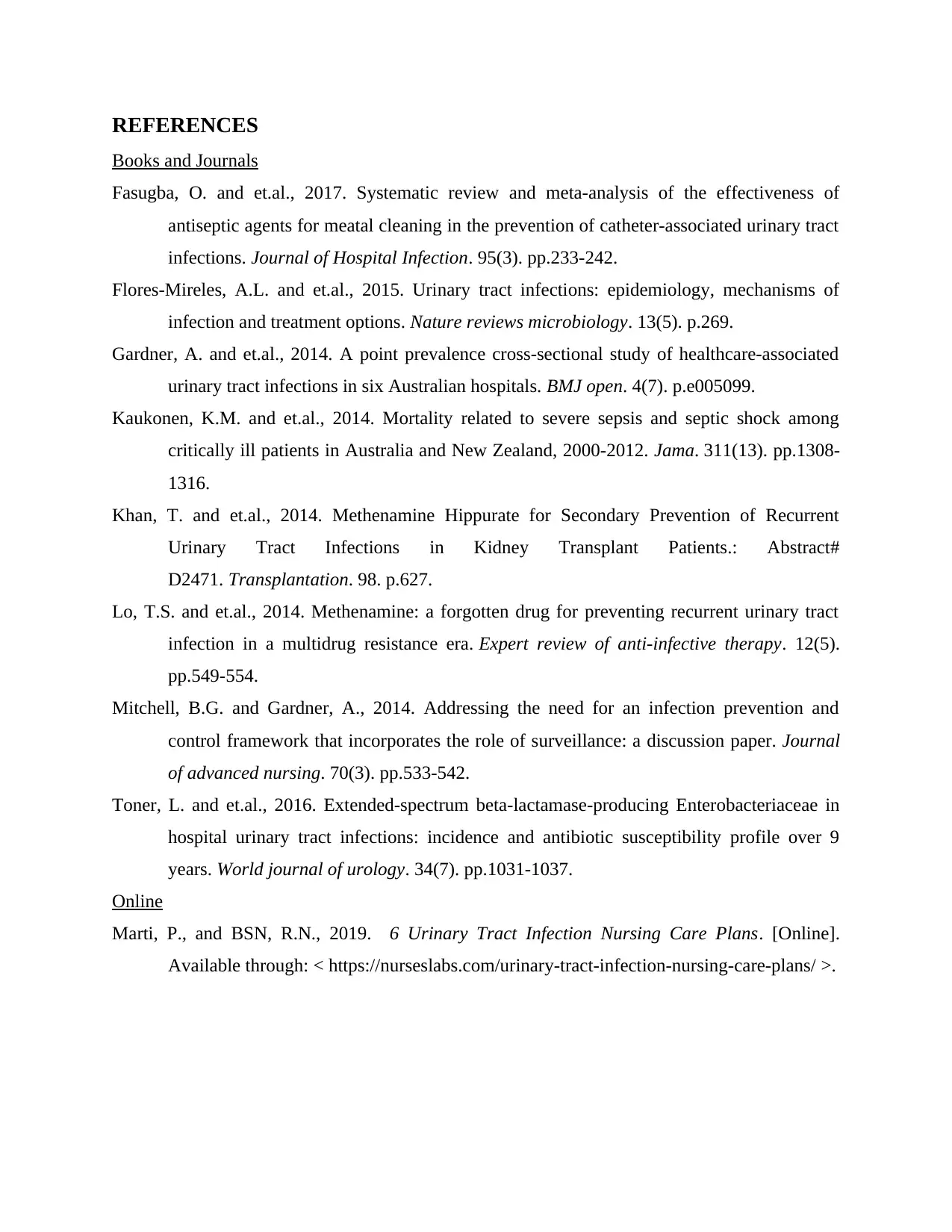Healthcare Report: Pathogenesis, Nursing Strategy, ABG Analysis of UTI
VerifiedAdded on 2020/10/22
|7
|1840
|117
Report
AI Summary
This report presents a detailed case study of a 75-year-old male patient, Mr. Kirkman, admitted to the emergency department with symptoms of a urinary tract infection (UTI). The report delves into the pathogenesis of the infection, examining the mechanisms by which the UTI developed, including the role of bacterial infection, potential contributing factors such as the use of a urinary catheter, and pre-existing conditions like chronic bronchitis and smoking. It identifies appropriate nursing strategies, such as the use of Mandelamine, and provides evidence-based rationales for these interventions, focusing on maintaining an acidic bladder environment to prevent bacterial growth. Furthermore, the report analyzes the patient's arterial blood gas (ABG) results, highlighting the presence of metabolic acidosis and elevated lactate levels, and correlating these findings with the patient's diagnosis of sepsis and history of smoking. The report concludes by summarizing the health variations observed, the clinical presentation, the nursing interventions implemented, and the ABG analysis, providing a comprehensive overview of the patient's condition and the healthcare management provided.

HEALTH VARIATION
Paraphrase This Document
Need a fresh take? Get an instant paraphrase of this document with our AI Paraphraser

TABLE OF CONTENTS
INTRODUCTION...........................................................................................................................3
MAIN BODY..................................................................................................................................3
Pathogenesis of clinical manifestation.........................................................................................3
Nursing strategy and its evidence-based rationale.......................................................................4
Analysis of Arterial blood gas results and its relation with pathogenesis...................................5
CONCLUSION................................................................................................................................5
REFERENCES................................................................................................................................7
INTRODUCTION...........................................................................................................................3
MAIN BODY..................................................................................................................................3
Pathogenesis of clinical manifestation.........................................................................................3
Nursing strategy and its evidence-based rationale.......................................................................4
Analysis of Arterial blood gas results and its relation with pathogenesis...................................5
CONCLUSION................................................................................................................................5
REFERENCES................................................................................................................................7

INTRODUCTION
Health variation in individual body denotes scope of improvement which depends on ability
to identify type of variating in health of person. The study is based on case study of 75-year-old
male Mr. Kirkman who has been presented in emergency department complaining of burning
sensation upon urination and lower abdominal pain radiating in right flank. The assignment will
outline pathogenesis of urinary tract infection on the basis of clinical records. Further, the study
will identify appropriate nursing strategy and analysis of arterial blood gas results with reference
to pathogenesis.
MAIN BODY
Pathogenesis of clinical manifestation
The pathogenesis of the disease can be defined as the biological mechanism progress of
disease showing its morphological feature or that leads to the diseased state. It can also be
described as the origin or development of the disease that can be acute, chronic or recurrent. It
has been analyzed from the case study that patient is a 75-year-old man who is suffering from
urinary tract infection. The patient was placed on IV NaCL and IV Sulfamethoxazole. Urinary
tract infection is caused by the microbes that includes bacteria which overcomes the system of
defense in the body, directly affecting the urinary tract. This disease can affect kidney, gall
bladder and tubes that run between them. Majority of the urinary tract infection in patient is
caused by the bacterium known as Escherichia Coli. UTI occurs with interaction of Uropathogen
and host. Uropathogen gets attached to epithelial surface which subsequently disseminates and
colonises through mucosa which causes tissue damage (Flores-Mireles and et.al., 2015). With
this period pathogens ascent into urinary bladder which results into asymptomatic and
symptomatic bacteria.
It has been analyzed that patient might be suffering from this infection due the urinary
catheter inserted inside him. The urinary tract infection is common in the older aged male. The
main reason behind it can be being immobile for the long periods, less consumption of the fluid.
Poor personal hygiene kept by the patient or service user can also be one of the reasons for the
development of this disease. It has also been analyzed from the case study that Mr. Kirkman has
also complaint about the burning sensation above the urination and lower abdominal pain
radiating into the right flank. His condition was detreating because of the infection. The body
temperature of the service user was measured at 39. It means that the patient was suffering from
Health variation in individual body denotes scope of improvement which depends on ability
to identify type of variating in health of person. The study is based on case study of 75-year-old
male Mr. Kirkman who has been presented in emergency department complaining of burning
sensation upon urination and lower abdominal pain radiating in right flank. The assignment will
outline pathogenesis of urinary tract infection on the basis of clinical records. Further, the study
will identify appropriate nursing strategy and analysis of arterial blood gas results with reference
to pathogenesis.
MAIN BODY
Pathogenesis of clinical manifestation
The pathogenesis of the disease can be defined as the biological mechanism progress of
disease showing its morphological feature or that leads to the diseased state. It can also be
described as the origin or development of the disease that can be acute, chronic or recurrent. It
has been analyzed from the case study that patient is a 75-year-old man who is suffering from
urinary tract infection. The patient was placed on IV NaCL and IV Sulfamethoxazole. Urinary
tract infection is caused by the microbes that includes bacteria which overcomes the system of
defense in the body, directly affecting the urinary tract. This disease can affect kidney, gall
bladder and tubes that run between them. Majority of the urinary tract infection in patient is
caused by the bacterium known as Escherichia Coli. UTI occurs with interaction of Uropathogen
and host. Uropathogen gets attached to epithelial surface which subsequently disseminates and
colonises through mucosa which causes tissue damage (Flores-Mireles and et.al., 2015). With
this period pathogens ascent into urinary bladder which results into asymptomatic and
symptomatic bacteria.
It has been analyzed that patient might be suffering from this infection due the urinary
catheter inserted inside him. The urinary tract infection is common in the older aged male. The
main reason behind it can be being immobile for the long periods, less consumption of the fluid.
Poor personal hygiene kept by the patient or service user can also be one of the reasons for the
development of this disease. It has also been analyzed from the case study that Mr. Kirkman has
also complaint about the burning sensation above the urination and lower abdominal pain
radiating into the right flank. His condition was detreating because of the infection. The body
temperature of the service user was measured at 39. It means that the patient was suffering from
⊘ This is a preview!⊘
Do you want full access?
Subscribe today to unlock all pages.

Trusted by 1+ million students worldwide

the high fever. The reason can be urinary tract infection. Also, the respiratory rate of the service
user was being 35 which is quite high. The rate for healthy person lies between 12-18 breathes. It
can be because, service user has the history of suffering from chronic Bronchitis on Ventolin and
Atrovent. The symptoms which can be seen in a patient going through Bronchitis can involve
body ache, headache, high fever.
The main reason behind service user suffering from this disease is smoking of cigars. It has
been analyzed from the case study that Mr. Kirkman was heavy smoker. He was engaged in
smoking 2 packs, a day since teenage. The diagnosis report of service user showed positive
nitrite in urine. It means the patient is suffering from chronic urinary tract infection. Patient is
suffering from lower abdominal pain and painful urination because of this disease. Also, health
care professionals had analyzed that the patient looked ill all the time. The report also showed
that the patient was is been suffering urinary tract infection and sepsis. The symptoms which can
be seen in this disease are fast respiratory rate, high fever and restless condition. It can be caused
because of the infection.
This disorder is mainly caused in an old aged patient. Sepsis is basically the life-
threatening condition that is caused by the body’s response to an infection. The body normally
releases chemical into the blood stream to fight and infection (Mitchell and Gardner, 2014). It
occurs when the body response to these chemicals is out of balance and triggering changes that
can affect multiple organs. It is caused mainly by the infection and the disease and can also cause
change in the mental condition of patient. In this disease the respiratory rate is higher than 22.
Nursing strategy and its evidence-based rationale
As per the views of Fasugba and et.al., 2017, urinary tract infection ion elderly aged male
is critical situation where patient experiences impaired urinary elimination, acute pain, infection,
hyperthermia and disturbed sleep pattern. Managing appropriate nursing strategy is essential to
ensure proper care of patient in ED like, palpating bladder of patient in every 4 hours which
helps in determining presence of urinary retention. In accordance with the condition and clinical
records of Mr. Kirkman health care provider will focus on maintaining acidic environment of
bladder for which health care worker will make use of agents like Vitamin C Mandelamine
which is urinary antiseptic. The motive behind this nursing strategy is to prevent growth of
bacteria. According to Marti and BSN, 2019, Methenamine is antibiotic which is used to prevent
infection as it prevents bacterial growth. It contains ingredients which helps in making urine
user was being 35 which is quite high. The rate for healthy person lies between 12-18 breathes. It
can be because, service user has the history of suffering from chronic Bronchitis on Ventolin and
Atrovent. The symptoms which can be seen in a patient going through Bronchitis can involve
body ache, headache, high fever.
The main reason behind service user suffering from this disease is smoking of cigars. It has
been analyzed from the case study that Mr. Kirkman was heavy smoker. He was engaged in
smoking 2 packs, a day since teenage. The diagnosis report of service user showed positive
nitrite in urine. It means the patient is suffering from chronic urinary tract infection. Patient is
suffering from lower abdominal pain and painful urination because of this disease. Also, health
care professionals had analyzed that the patient looked ill all the time. The report also showed
that the patient was is been suffering urinary tract infection and sepsis. The symptoms which can
be seen in this disease are fast respiratory rate, high fever and restless condition. It can be caused
because of the infection.
This disorder is mainly caused in an old aged patient. Sepsis is basically the life-
threatening condition that is caused by the body’s response to an infection. The body normally
releases chemical into the blood stream to fight and infection (Mitchell and Gardner, 2014). It
occurs when the body response to these chemicals is out of balance and triggering changes that
can affect multiple organs. It is caused mainly by the infection and the disease and can also cause
change in the mental condition of patient. In this disease the respiratory rate is higher than 22.
Nursing strategy and its evidence-based rationale
As per the views of Fasugba and et.al., 2017, urinary tract infection ion elderly aged male
is critical situation where patient experiences impaired urinary elimination, acute pain, infection,
hyperthermia and disturbed sleep pattern. Managing appropriate nursing strategy is essential to
ensure proper care of patient in ED like, palpating bladder of patient in every 4 hours which
helps in determining presence of urinary retention. In accordance with the condition and clinical
records of Mr. Kirkman health care provider will focus on maintaining acidic environment of
bladder for which health care worker will make use of agents like Vitamin C Mandelamine
which is urinary antiseptic. The motive behind this nursing strategy is to prevent growth of
bacteria. According to Marti and BSN, 2019, Methenamine is antibiotic which is used to prevent
infection as it prevents bacterial growth. It contains ingredients which helps in making urine
Paraphrase This Document
Need a fresh take? Get an instant paraphrase of this document with our AI Paraphraser

acidic and when the urine is acidic, it turns into formaldehyde to destroy bacteria (Khan and
et.al., 2014). However, Lo and et.al., 2014, stated that using Mandelamine is effective nursing
strategy when managing patient suffering from Urinary tract infection because it has minimal
side effects, cost effective and is well tolerated.
Analysis of Arterial blood gas results and its relation with pathogenesis
Results of arterial blood gas comprise pH which refers to acidosis and alkalosis in blood
which seems to be normal in case of Mr. Kirkman as it is 7.25. Further, partial pressure of
oxygen in alveoli is 75 mmHg which is also normal. Apart from this, base excess is -6 which
denotes reduce in base which reflects metabolic acidosis. In accordance with this, it can be said
that body of patient is producing excessive quantity of acid which can be due to excessive
smoking and sepsis which was diagnosed with UTI. According to Gardner and et.al., 2014,
metabolic acidosis is common in-service users who are critically suffering from sepsis. It is the
cause of metabolic acidosis because in this situation body of service user starts releasing
chemicals in blood stream. However, patient in ED is replying in one word and has low blood
pressure which can due to septicemia which leads to low blood pressure, difficulty in breathing
and mental confusion.
On the other hand, lactate result was patient was recorded at 3.2 mmol/L which is
extremely high and denotes critical condition of patient which can be due to lack of oxygen. In
accordance with this analysis it can be said that organs of Mr. Kirkman are not working properly
which is due to Sepsis. According to Kaukonen and et.al., 2014, increase in level of lactic acid
occurs in case of severe sepsis infection which reduces flow of blood and oxygen in the. It is an
extreme and life-threatening condition which is also known as lactic acidosis. Also, as per
history of patient it is clear that Mr. Kirkman smokes excessive cigarettes and acute smoking
increase lactate flux during exercise. In addition, Toner and et.al., 2016, stated that regular
smokers have higher rate of lactate to glucose conversion which increases glucose dependency of
service users. Thus, it can be outline that increase level of lactate and reduced base excess is
related with history and diagnosis of sepsis.
CONCLUSION
The report summarized about the health variation which depicts individual ability to cope
with the illness or medical condition. The assessment is based on 78-year-old male Mr. Kirkman
who was presented in Emergency department complaining for burning sensation upon urination
et.al., 2014). However, Lo and et.al., 2014, stated that using Mandelamine is effective nursing
strategy when managing patient suffering from Urinary tract infection because it has minimal
side effects, cost effective and is well tolerated.
Analysis of Arterial blood gas results and its relation with pathogenesis
Results of arterial blood gas comprise pH which refers to acidosis and alkalosis in blood
which seems to be normal in case of Mr. Kirkman as it is 7.25. Further, partial pressure of
oxygen in alveoli is 75 mmHg which is also normal. Apart from this, base excess is -6 which
denotes reduce in base which reflects metabolic acidosis. In accordance with this, it can be said
that body of patient is producing excessive quantity of acid which can be due to excessive
smoking and sepsis which was diagnosed with UTI. According to Gardner and et.al., 2014,
metabolic acidosis is common in-service users who are critically suffering from sepsis. It is the
cause of metabolic acidosis because in this situation body of service user starts releasing
chemicals in blood stream. However, patient in ED is replying in one word and has low blood
pressure which can due to septicemia which leads to low blood pressure, difficulty in breathing
and mental confusion.
On the other hand, lactate result was patient was recorded at 3.2 mmol/L which is
extremely high and denotes critical condition of patient which can be due to lack of oxygen. In
accordance with this analysis it can be said that organs of Mr. Kirkman are not working properly
which is due to Sepsis. According to Kaukonen and et.al., 2014, increase in level of lactic acid
occurs in case of severe sepsis infection which reduces flow of blood and oxygen in the. It is an
extreme and life-threatening condition which is also known as lactic acidosis. Also, as per
history of patient it is clear that Mr. Kirkman smokes excessive cigarettes and acute smoking
increase lactate flux during exercise. In addition, Toner and et.al., 2016, stated that regular
smokers have higher rate of lactate to glucose conversion which increases glucose dependency of
service users. Thus, it can be outline that increase level of lactate and reduced base excess is
related with history and diagnosis of sepsis.
CONCLUSION
The report summarized about the health variation which depicts individual ability to cope
with the illness or medical condition. The assessment is based on 78-year-old male Mr. Kirkman
who was presented in Emergency department complaining for burning sensation upon urination

and lower abdominal pain. The study outlined Pathogenesis of clinical condition of service user
on the basis of observation records which presented diagnosis of sepsis and UTI. Also, it
identified nursing strategy which is use of Mandelamine to main acidic environment of bladder.
Thus, it concluded with analysis of arterial blood gas which presented increase in lactate and
base excess.
on the basis of observation records which presented diagnosis of sepsis and UTI. Also, it
identified nursing strategy which is use of Mandelamine to main acidic environment of bladder.
Thus, it concluded with analysis of arterial blood gas which presented increase in lactate and
base excess.
⊘ This is a preview!⊘
Do you want full access?
Subscribe today to unlock all pages.

Trusted by 1+ million students worldwide

REFERENCES
Books and Journals
Fasugba, O. and et.al., 2017. Systematic review and meta-analysis of the effectiveness of
antiseptic agents for meatal cleaning in the prevention of catheter-associated urinary tract
infections. Journal of Hospital Infection. 95(3). pp.233-242.
Flores-Mireles, A.L. and et.al., 2015. Urinary tract infections: epidemiology, mechanisms of
infection and treatment options. Nature reviews microbiology. 13(5). p.269.
Gardner, A. and et.al., 2014. A point prevalence cross-sectional study of healthcare-associated
urinary tract infections in six Australian hospitals. BMJ open. 4(7). p.e005099.
Kaukonen, K.M. and et.al., 2014. Mortality related to severe sepsis and septic shock among
critically ill patients in Australia and New Zealand, 2000-2012. Jama. 311(13). pp.1308-
1316.
Khan, T. and et.al., 2014. Methenamine Hippurate for Secondary Prevention of Recurrent
Urinary Tract Infections in Kidney Transplant Patients.: Abstract#
D2471. Transplantation. 98. p.627.
Lo, T.S. and et.al., 2014. Methenamine: a forgotten drug for preventing recurrent urinary tract
infection in a multidrug resistance era. Expert review of anti-infective therapy. 12(5).
pp.549-554.
Mitchell, B.G. and Gardner, A., 2014. Addressing the need for an infection prevention and
control framework that incorporates the role of surveillance: a discussion paper. Journal
of advanced nursing. 70(3). pp.533-542.
Toner, L. and et.al., 2016. Extended-spectrum beta-lactamase-producing Enterobacteriaceae in
hospital urinary tract infections: incidence and antibiotic susceptibility profile over 9
years. World journal of urology. 34(7). pp.1031-1037.
Online
Marti, P., and BSN, R.N., 2019. 6 Urinary Tract Infection Nursing Care Plans. [Online].
Available through: < https://nurseslabs.com/urinary-tract-infection-nursing-care-plans/ >.
Books and Journals
Fasugba, O. and et.al., 2017. Systematic review and meta-analysis of the effectiveness of
antiseptic agents for meatal cleaning in the prevention of catheter-associated urinary tract
infections. Journal of Hospital Infection. 95(3). pp.233-242.
Flores-Mireles, A.L. and et.al., 2015. Urinary tract infections: epidemiology, mechanisms of
infection and treatment options. Nature reviews microbiology. 13(5). p.269.
Gardner, A. and et.al., 2014. A point prevalence cross-sectional study of healthcare-associated
urinary tract infections in six Australian hospitals. BMJ open. 4(7). p.e005099.
Kaukonen, K.M. and et.al., 2014. Mortality related to severe sepsis and septic shock among
critically ill patients in Australia and New Zealand, 2000-2012. Jama. 311(13). pp.1308-
1316.
Khan, T. and et.al., 2014. Methenamine Hippurate for Secondary Prevention of Recurrent
Urinary Tract Infections in Kidney Transplant Patients.: Abstract#
D2471. Transplantation. 98. p.627.
Lo, T.S. and et.al., 2014. Methenamine: a forgotten drug for preventing recurrent urinary tract
infection in a multidrug resistance era. Expert review of anti-infective therapy. 12(5).
pp.549-554.
Mitchell, B.G. and Gardner, A., 2014. Addressing the need for an infection prevention and
control framework that incorporates the role of surveillance: a discussion paper. Journal
of advanced nursing. 70(3). pp.533-542.
Toner, L. and et.al., 2016. Extended-spectrum beta-lactamase-producing Enterobacteriaceae in
hospital urinary tract infections: incidence and antibiotic susceptibility profile over 9
years. World journal of urology. 34(7). pp.1031-1037.
Online
Marti, P., and BSN, R.N., 2019. 6 Urinary Tract Infection Nursing Care Plans. [Online].
Available through: < https://nurseslabs.com/urinary-tract-infection-nursing-care-plans/ >.
1 out of 7
Related Documents
Your All-in-One AI-Powered Toolkit for Academic Success.
+13062052269
info@desklib.com
Available 24*7 on WhatsApp / Email
![[object Object]](/_next/static/media/star-bottom.7253800d.svg)
Unlock your academic potential
Copyright © 2020–2025 A2Z Services. All Rights Reserved. Developed and managed by ZUCOL.





